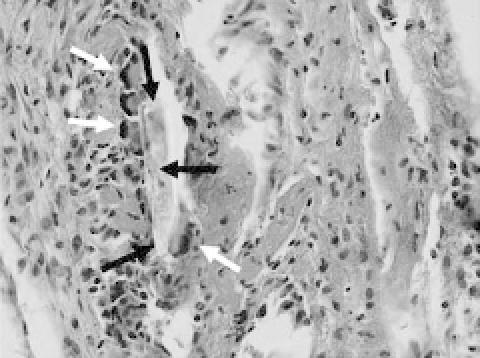Biomedical Engineering Reference
In-Depth Information
Figure 16.1.
Foreign body granuloma. Small PLGA debris (black arrows)
broken off from the PLGA film, surrounded by macrophages and multinu-
cleated giant cells (white arrows). These induced macrophages and multin-
ucleated giant cells were remaining over 2 months.
available, it is usually complicated to prepare the implants, and
adverse effects of a specific growth factor have not been clearly
defined. In addition, the mechanisms by which PLGA induces local
inflammatory responses have notbeen discussed su
ciently.
8
In our laboratory, the natural/synthetic hybrid scaffolds have
been investigated during the last 15 years, such as SIS,
9
,
10
DBPs,
8
,
11
DBP gel,
12
fibrin,
13
keratin,
14
hyaluronic acid,
15
collagen gel,
4
silk,
4
and a 2-methacryloyloxyethyl phosphorylcholine (MPC) polymer
(PMEH)
16
with PLGA to reduce cellular inflammatory response. In
this chapter, we introduced (1) fibrin/PLGA hybrid scaffolds for the
regeneration of disc and cartilage and (2) DBP/PLGA and SIS/PLGA
hybrid scaffolds in terms of scaffold design for the reduction of host
response andthe augmentation of tissue formation.
16.2 Fibrin/PLGA Hybrid Scaffolds
16.2.1
Fibrin/PLGA Hybrid Scaffolds for Cartilage
Regeneration
in vivo
and
in vitro
Articular cartilage has a limited potential to repair; consequently,
damaged articular cartilage will further degenerate and eventually









Search WWH ::

Custom Search